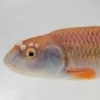Thanks for the indispensible information, Gerlad (why I love this forum). In regards to your questions -- yes, the triploid dace are all females. We've got two amazing things going on here at once, so it can get a little confusing. On one hand, we have all female
C. eos-
neogaeus diploid hybrids that are gynogenetic; so these all female, diploid gynogentic
C. eos-
neogaeus will spawn with male
C. eos. Now, since they're supposed to be true gynogens, they just use the sperm to activate (and not incorporate) their reproduction, so they can clonally pass on their
C. eos-
neogaeus diploid genomes to produce identical all female, diploid
C. eos-
neogaeus. However, that sperm often gets incorporated (snygamy) so you have haploid
C. eos sperm fusing with the
C. eos-
neogaus diploid ova that the females are 'trying' to pass on clonally. This is the only way to get triploids, and it is de novo each generation.
On the other hand, the triploids created from this process can go off to reproduce sexually. The all female, triploid
C. eos-
eos-
neogaus will do two reductional divisions so her eggs have one genome (EEN ----> EE ----> E). So at the end of these reductional divisions, even though the female is a triploid, she is gametically no different than a diploid, bisexual
C. eos. These triploid females then mate with male
C. eos and the females E meets up with the males haploid sperm (the other E) to restore the diploid condition (EE) -- a normal
C. eos (EE); so from this you have triploids (
C. eos-
eos-
neogaues) giving rise to fully normal bisexual and diploid
C. eos. Since the all female, gynogenetic hybrids (
C. eos-
neogaeus) often incorporate genetic matieral from sperm, their reproductive mode might be best termed 'kleptogenesis' instead of '
gynogenesis'. The triploid
Ambystoma (mole salamanders) do something very similar -- ocassionally incorpating genetic material. This might be the very reason these evolutionary dead ends (the antithesis of sex) have been around for millions of years.
Edited by blakemarkwell, 15 February 2012 - 01:37 PM.










